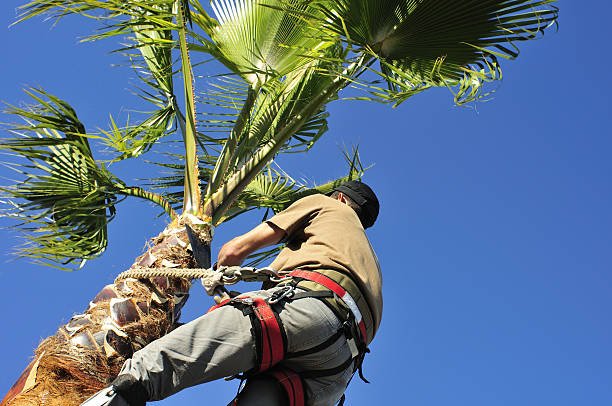Palm trees are one of the most iconic symbols of California. Whether you’re walking along the boulevards of Los Angeles, enjoying the coastal breeze in San Diego, or admiring landscaped gardens in San Jose, palms create a tropical, timeless charm that defines much of the Golden State’s beauty. But as beautiful as they are, palms aren’t maintenance-free. To thrive, they need consistent care, proper pruning, and protection from pests and diseases.
In this detailed guide, we’ll explore everything you need to know about palm tree care in California—from routine palm tree maintenance and watering schedules to fertilization, pruning techniques, and answers to common questions like “How do you prune a majesty palm?” For professional help in the Bay Area, you can also check out our Palm Tree Service in San Jose for expert local care.
Why Palm Trees Need Specialized Care
Unlike many native California trees, palms are exotic imports. Varieties like the Canary Island Date Palm, Mexican Fan Palm, Queen Palm, and Majesty Palm come from tropical and subtropical regions. That means they’re adapted to warm, sunny climates but still require care tailored to California’s soil conditions, seasonal weather changes, and urban landscaping.
Without proper maintenance, palms can:
- Develop yellowing or drooping fronds
- Suffer from nutrient deficiencies
- Attract pests such as palm weevils and scale insects
- Grow unsafely, with dead fronds posing hazards to property and people
That’s why palm tree maintenance should be an ongoing priority if you want your trees to remain healthy, safe, and beautiful year-round.
Palm Tree Maintenance Basics
1. Watering Palm Trees in California
California’s climate varies widely—from coastal humidity to inland dryness—so watering schedules depend on location.
- Young palms (newly planted) need deep watering 2–3 times a week until their roots are established.
- Mature palms generally need watering once every 1–2 weeks, depending on rainfall.
- Always water deeply, allowing moisture to soak into the root zone. Shallow watering leads to weak root systems.
Pro Tip: Use drip irrigation or a soaker hose to ensure consistent, slow watering.
2. Fertilizing Palm Trees
Palms are heavy feeders and often suffer from nutrient deficiencies in California soils. Key nutrients include:
- Nitrogen (N) – promotes lush green growth
- Potassium (K) – essential for overall health
- Magnesium (Mg) – prevents yellowing leaves
- Manganese (Mn) – prevents “frizzle top,” a common palm disease
Apply a slow-release palm fertilizer three to four times a year (spring through early fall). Spread it evenly around the root zone, but not too close to the trunk to avoid damage.
3. Mulching
Mulch helps retain soil moisture, suppress weeds, and regulate temperature around palm roots. Spread 2–3 inches of organic mulch (wood chips, bark, or palm fronds) around the base, keeping it 6–8 inches away from the trunk to prevent rot.
4. Pest & Disease Control
California palms are vulnerable to:
- Red Palm Weevil – bores into the trunk, often fatal if untreated
- Palm Scale – small, sap-sucking insects that weaken the tree
- Fusarium Wilt – a fungal disease causing fronds to brown and die
Early detection is crucial. Regularly inspect fronds and trunks, and contact a certified arborist if you notice unusual discoloration, holes, or drooping fronds.
How to Prune Palm Trees Properly
Pruning is one of the most important aspects of palm tree maintenance. Proper pruning enhances appearance, prevents hazards, and improves tree health. But pruning palms isn’t the same as trimming regular trees. Over-pruning or incorrect cuts can permanently damage the palm.
Why Prune Palm Trees?
- Remove dead or dying fronds that may fall and cause injury
- Eliminate fruit stalks and seeds that attract pests
- Improve airflow and reduce fire hazards
- Enhance the aesthetic appeal of your landscape
General Palm Pruning Rules
- Don’t over-prune. Palms need their fronds to photosynthesize. Removing too many fronds weakens the tree.
- Only remove brown, dead, or diseased fronds. Green fronds, even if slightly yellow, are still feeding the palm.
- Cut close, but not flush. Leave a small base instead of cutting into the trunk.
- Avoid climbing spikes. They wound the trunk and make the palm vulnerable to disease.
How Do You Prune a Majesty Palm?
The Majesty Palm (Ravenea rivularis) is a popular ornamental palm often grown indoors or in California landscapes. Unlike towering date palms, Majesty Palms stay relatively small and have delicate fronds.
Here’s a step-by-step guide on how to prune a Majesty Palm safely:
- Inspect the Palm
Look for fronds that are completely brown, yellow, or broken. Healthy green fronds should never be cut. - Gather Tools
- Pruning shears for smaller fronds
- Loppers for thicker fronds
- Gloves to protect your hands from sharp edges
- Identify the Right Fronds to Cut
- Remove only the lowest fronds (at the bottom of the crown) that are brown or brittle
- Cut flower or fruit stalks, as they drain energy from the palm
- Make Clean Cuts
Position your shears or loppers close to the trunk but not cutting into it. Always make smooth cuts to avoid leaving ragged wounds. - Check for Pests
Majesty Palms are prone to spider mites and mealybugs. After pruning, inspect the fronds and treat with neem oil if necessary.
Important: Majesty Palms are sensitive. Excessive pruning can stunt growth and cause long-term stress. Stick to minimal, selective cuts.
Seasonal Palm Tree Care in California
Spring
- Fertilize to support new growth
- Prune any winter-damaged fronds
- Begin a regular watering schedule as temperatures rise
Summer
- Monitor for pests, especially in hot inland areas
- Increase watering frequency in drought-prone regions
- Remove seed pods and fruit stalks to reduce litter
Fall
- Apply the last round of fertilizer before winter
- Clean up dead fronds to prevent fire hazards
- Inspect for fungal diseases after autumn rains
Winter
- In coastal regions, minimal care is needed
- In colder inland areas, protect sensitive palms (like Majesty Palms) with frost cloths if temperatures dip below 40°F
Common Mistakes in Palm Tree Care
- Topping Palms: Unlike other trees, palms cannot regrow from severe topping.
- Overwatering: Leads to root rot, especially in clay soils.
- Using Regular Fertilizer: Palms need specific palm fertilizers with manganese and magnesium.
- Neglecting Pruning: Allowing too many dead fronds increases hazards and pests.
DIY vs. Professional Palm Care
Small palms like Majesty Palms or Pygmy Date Palms can usually be maintained by homeowners. But for tall species like Mexican Fan Palms or Canary Island Date Palms, professional arborists are strongly recommended.
Why hire professionals?
- They have the right equipment (bucket trucks, safety gear)
- They know proper pruning techniques
- They can spot early signs of disease or infestation
- They reduce the risk of injury and property damage
FAQs About Palm Tree Care
1. How often should palm trees be trimmed in California?
Once or twice a year is usually enough. Over-pruning can weaken the tree.
2. Do palms need a lot of water?
Young palms do. Mature palms are more drought-tolerant but still need deep watering every couple of weeks in dry climates.
3. How do I keep my Majesty Palm healthy indoors?
Place it in bright, indirect light, water when the top inch of soil is dry, and mist regularly to increase humidity.
4. Can cold weather damage palms?
Yes. While many palms tolerate mild California winters, frost-sensitive species should be covered or moved indoors during cold snaps.
Conclusion
Caring for palm trees in California requires a balance of proper watering, fertilization, pest management, and pruning. Whether you’re maintaining a stately Canary Island Date Palm in your front yard or wondering “How do you prune a Majesty Palm?” indoors, the key is consistency and attention to detail.
Healthy palms not only enhance curb appeal but also add long-lasting value to your property. With the right maintenance practices—or the help of professional arborists—your palms can continue to thrive and symbolize the beauty of California for years to come.

